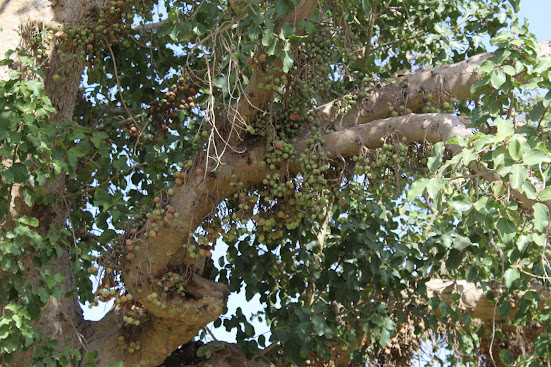The sycamore (Hebrew: shikma; Gr. Sycomoros) - is derived from the root shin, kuf, mem - meaning to restore, regenerate, reestablish.
Because of its resemblance to the
fig-tree, and leaves like those of the mulberry, the tree is called the
fig-mulberry (Ficus sycomorus). Most people know the sycamore as the ‘Acer
pseudo platanus’, a maple species often called a plane-tree. The clustered fruits
look like small figs; they are sweet, but not as good as the true fig.
Sycamore trees were of high economic and cultural significance in the Near East. In ancient times the tree was known as the "fig of Pharaoh," and Egypt as "the land where the sycamore tree blooms."
The Egyptians considered its shadow
as a delight. With its wood they built coffins for the mummies as the sycamore
fig is one of the few trees in the region to obtain a girth great enough for
this use. The wood of the sycamore was held in relatively higher esteem than
its fruit. It was used extensively in building and wherever long and stout
beams were needed.
“I was a herdsman, and a dresser of sycamore trees.” Amos 7:14 The word“dresser” should have been tr. “cultivator.” While the sheep were grazing, shepherds often tended the sycamore trees by puncturing the fruit with the point of a knife - otherwise the fruit would be inedible.
"The tree's yield is extremely prolific, but only when iron hooks are used to make incisions in the fruit, which otherwise does nor ripen. When this is done the fruit is picked three days later, while another fig forms beneath it; the tree thus has seven crops of very juicy figs in a single summer.” Pliny the Elder, Natural History - Books XIII Trees.
Once widespread in Israel in Biblical times, its value was so great that David appointed for them in his kingdom a special overseer, (1 Chronicles 27:28): " Baal-Hanan the Gederite was in charge of the olive and sycamore-fig trees in the western foothills."
During the time of King Solomon (I
Kings. 10:27) " The king made silver as common in Jerusalem as stones, and
cedar as plentiful as sycamore-fig trees in the foothills."
In the Bible, despite their different properties, the sycamore tree is often accompanied by the olive tree. The olive tree, symbolizing reproduction, can survive many days without water and be easily transplanted. While drying out quickly, the sycamore tree symbolizes regeneration. Wind uncovered roots will grow even deeper into the ground, clinging solidly to it; if the sand covers its branches, they transform themselves into roots giving rise to new trees.
In Israel, the trees grow mainly in the coastal plain and Jordan Valley. The Sycamore flowers and produces fruit during the hot summer months. A single tree may produce up to six crops in one year. Figs found on the tree during the winter months are few and develop slowly.
“He entered Jericho and was passing through. And behold, there was a man named Zacchaeus. He was a chief tax collector and was rich. And he was seeking to see who Jesus was, but on account of the crowd he could not, because he was small in stature. So he ran on ahead and climbed up into a sycamore tree to see him, for he was about to pass that way.” Luke 19:1-4 ESV
Even though Jericho was known in the Bible as “the city of palm trees” (Deuteronomy 34:3), Zacchaeus preferred to climb the evergreen’s thick trunk and hide between the leathery leaves. He thought nobody noticed, until the Lord Jesus looked up!
In ancient Israel, sycamore was eaten mostly by the poor who could not afford the more expensive fruits. Over the years, the fruit of the sycamore has lost its importance. Other high-quality fruit trees have come into the region, and the sycamores are now gradually disappearing. Except, of course, for Zacchaeus’ famous tree in Jericho.
Text and pictures: copyright: 2021 Petra van der Zande





